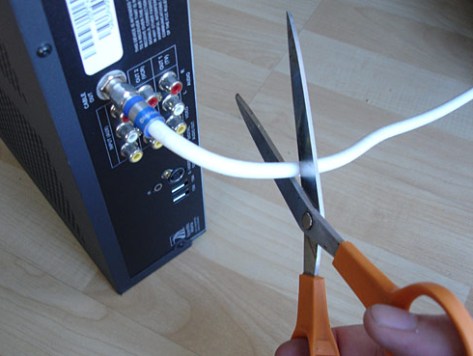
This is huge, huge news. But don’t get too excited. For now at least, the à la carte “cable television” service will only be available on your mobile devices. Though it happened a few years sooner than I would have expected, the news also isn’t a big surprise. It was just a matter of time before our Bundled Cable Overlords came to terms with the reality of reality.
During a Thursday appearance at a Goldman Sachs technology conference, Verizon Communications chief Lowell McAdam said the service will likely include access to the “big four” broadcast networks, as well as “custom channels.”
“No one wants to have 300 channels on your wireless device,” McAdam said. “And I think everyone understands. It will go to à la carte.”
Major cable and pay TV services have long resisted an “à la carte” approach that would let customers pick and choose the channels they want to pay for rather than pay for a bundle of 300+ channels. For about a decade, they have argued that à la carte would result in increased pricing and less channel diversity.
And while that probably won’t change for traditional cable customers anytime soon, McAdam acknowledged that when it comes to the Web and mobile, a different approach is necessary.
As far as the future is concerned, the most important sentence in those four paragraphs is, “No one wants 300 channels on your wireless device.”
That’s exactly right. And eventually, everything is going wireless. When that happens, do you really want 100 or 200 or 300 channel apps on your iPhone, iPad, or Roku player?
Nope.
And that, along with cost, is why bundled cable’s days are numbered.
The future is so gosh-darned Now that HBO is publicly considering a break from bundled cable that would offer its beloved HBO Go service as a standalone streaming service. This would be the first cable channel to break from the Bundled Cable Plantation. If HBO makes it work, if it’s profitable, how many others would follow: TCM, AMC, FX, ABC, Fox News?
If our Bundled Cable Overlords won’t give us à la carte, it might happen by way of individual networks doing it on their own.
In just one year, the number of Netflix subscribers jumped from 29.81 million to 36.26 million. In just three years, the number of homes that cut the cable or satellite cord completely jumped from 5.1 million households to 7.6 million. While the U.S. population increases every year, the number of households (around 100 million) that pay for cable is stagnant or decreasing slightly. Just a few years ago, everyone looked at services such as Hulu and Netflix Streaming as added services and revenue streams for entertainment providers, not disruptors like Napster.
The monkey in that wrench is young people – the demographics. Young adults are cutting the cord faster than any other age group. Almost a quarter of young adults who subscribe to Netflix or Hulu do not pay for a cable or satellite service. This is the very age group television advertisers covet more than any other.
Verizon is obviously looking 20 years into the future with the clarity to understand that if nothing changes, an apocalypse will hit bundled cable. Like the cockroach, only Netflix and others like it will stand. Moreover, if Verizon can make an early move and be the first to offer a form of cable television online, they can capture that market.
The next phase, the endgame, is when a Verizon makes the jump from offering à la carte on your portable devices to the television in your living room (and how hard will this be for the tech-savvy to do right away?). That’s the last stage, and it’s only a matter of time.
Bundled cable will try to keep the legal racket that is its current business model alive for as long as possible, and will probably try to replicate it online. But it is already too late. In six short years, there will be somewhere around 80 million Millennials aged 20 to 40. They have not only been socialized into streaming and the cheaper subscription prices that come with it; they have been battered by the Great Recession and President Obama’s stunning mishandling of the recovery. Like the Depression-era generation, Obama’s Lost Decade has taught generations to pinch pennies.
The best news is that in this new world of à la carte, the customer again will control the culture, not giant left-wing conglomerates that own bundled cable. Individual networks will rise and fall based solely on the number of people willing to pay for them. Because we won’t be forced into bundled cable packages that in turn force us to pay for networks that poison our families and culture (MTV, CNN, MSNBC), these networks will lose gajillions of dollars.
Some experts predict the end of bundled cable will mean the end of over 80 networks.
Imagine there’s no CNN, you can if you try…
Follow John Nolte on Twitter @NolteNC

COMMENTS
Please let us know if you're having issues with commenting.